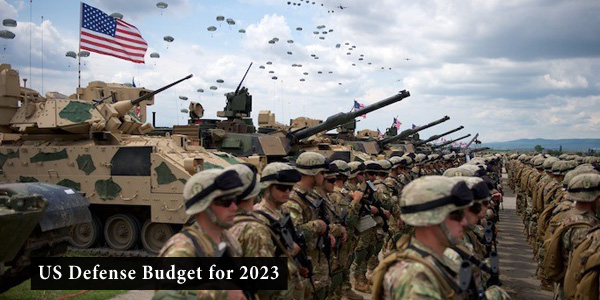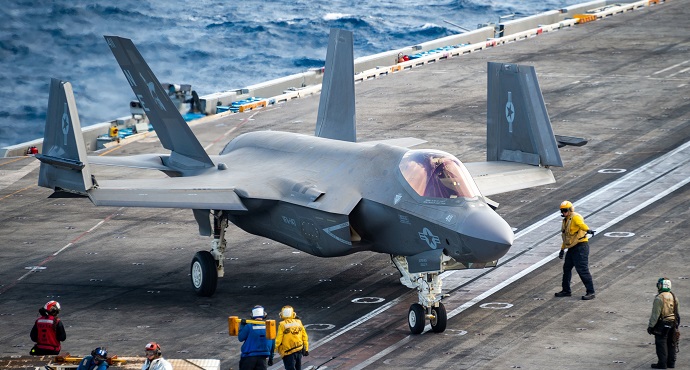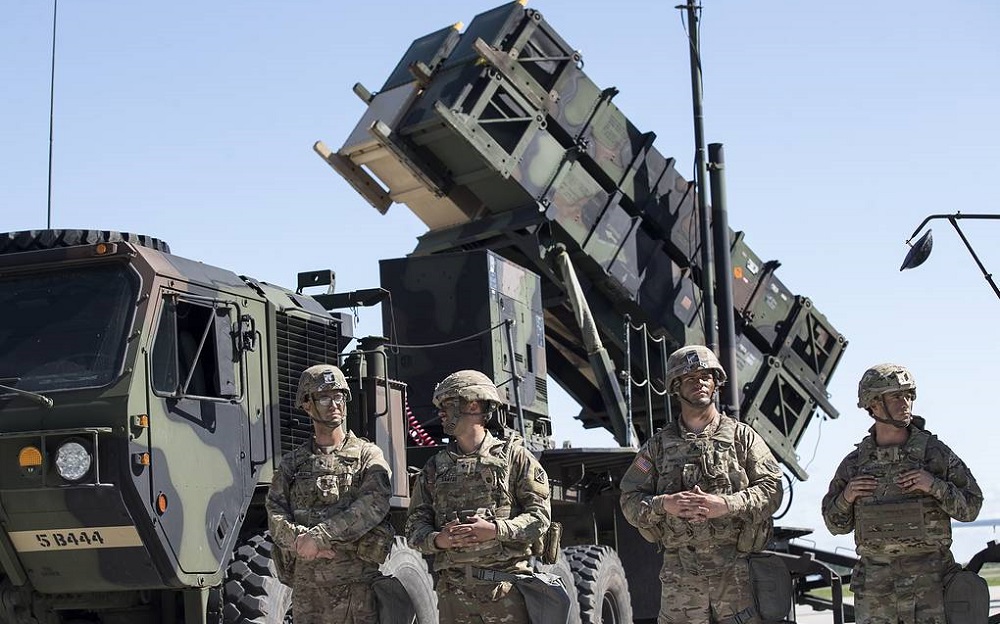United States Defense Budget for 2023
IRIA Staff - January 17, 2023

The National Defense Authorization Act for the financial year 2023 has ensured the provision of a record $858 billion fund for defense spending in the United States. It marks one of the largest defense budgets in the history of the U.S. The amount exceeds defense spending by any other nation in the world and it is $45 billion more than the previous year. The U.S.’s yearly defense budget exceeds that of the next nine countries combined. Washington’s defense spending in 2021 accounted for almost 40 percent of the world’s total military spending.
A major share of this budget, $816.7 billion has been designated for the Department of Defence. Most of the rest is destined for national security programs within the Department of Energy which accounts for $30.3 billion. Other Defense-related Activities Outside NDAA Jurisdiction are allocated $10.6 billion.
The 4500-page long document of NDAA covers a wide range of topics related to U.S. national security as well as other international issues in complete detail. The document also proclaimed the U.S. spending plans for issues related to security including efforts to bolster Washington’s support for Ukraine and the NATO alliance, a focus on China, and mandates related to combatting the Middle East’s drug trade.
The act also ends the mandatory requirement for the troops to receive the COVID-19 vaccine. However, it does not state whether the military would reinstate the troops who were discharged for refusing to take the vaccine. The White House and congress have different approaches toward the vaccine mandate for the U.S. military.
The U.S. seeks to expand its footholds in the Indo-Pacific region and the act extends the Pacific Deterrence Initiative through the fiscal year and identifies approximately $11.5 billion of investments in support of the initiative’s objective.
 Sailors taxi an F-35C Lightning II, assigned to the “Argonauts” of Strike Fighter Squadron (VFA) 147, on the flight deck of Nimitz-class aircraft carrier USS Carl Vinson (CVN-70), on Jan. 22, 2022. (Image Credit: US Navy)
Sailors taxi an F-35C Lightning II, assigned to the “Argonauts” of Strike Fighter Squadron (VFA) 147, on the flight deck of Nimitz-class aircraft carrier USS Carl Vinson (CVN-70), on Jan. 22, 2022. (Image Credit: US Navy)
Some salient features of the U.S. Defense Budget 2023:
- The budget authorizes a 4.6% increase in salary for the military servicemen and the Department of Defense workforce. The increase in salaries has been made considering the increasing inflation.
- The budget has also authorized the procurement of several latest combat aircraft and munition systems. Most prominently additional funding has been approved for the development of F-35A aircraft, HH-60W helicopters, F-22 Block 20 aircraft as well as E-7 aircraft that support airborne command and control operations.
- The budget also approves additional funds for vehicle safety and data collection updates for the high mobility multipurpose armored wheeled vehicles as well as increased funding for Patriot air defense systems to include a focus on industrial preparedness.
- A large share of the defense budget would be spent on naval expansion. The 2023 defense budget authorizes contracts for the procurement of up to 25 ship-to-shore connectors, 15 Arleigh Burke-class destroyers, eight Lewis-class oilers, five amphibious ships, and CH-53K helicopters. $32.6 billion funds have been approved for Navy shipbuilding, and an increase of $4.7 billion has been approved for the procurement of 11 battle force ships:
• 3 Arleigh Burke-class destroyers
• 2 Virginia-class submarines
• 2 expeditionary fast means of transport
• 1 Constellation-class frigate
• 1 San Antonio-class amphibious
• 1 John Lewis class oiler
• 1 Navajo-class towing, salvage, and rescue ship
 The Arleigh Burke-class guided-missile destroyer USS Ralph Johnson (DDG 114) and the Ticonderoga-class guided-missile cruiser USS Princeton (CG 59) steam in formation during dual carrier operations with the Nimitz and Theodore Roosevelt Carrier Strike Groups. (Image Credit: U.S. Navy Mass Communication Specialist 1st Class John Philip Wagner, Jr.)
The Arleigh Burke-class guided-missile destroyer USS Ralph Johnson (DDG 114) and the Ticonderoga-class guided-missile cruiser USS Princeton (CG 59) steam in formation during dual carrier operations with the Nimitz and Theodore Roosevelt Carrier Strike Groups. (Image Credit: U.S. Navy Mass Communication Specialist 1st Class John Philip Wagner, Jr.)
Funds for Ukraine
Many observers have pointed out that the U.S.’s largest defense budget has come at a time when its military is not actively engaged in a warzone. The U.S. ended its campaign in Afghanistan in 2021 and pulled out its forces. One of the main reasons for an increase in the defense budget is the ongoing Ukraine war. It is not from the defense budget that Washington D.C. would provide military aid to Ukraine, as only $800 million of 0.09% of the total defense budget is going directly toward that conflict.
A far bigger tranche of military aid for Kyiv is expected to pass through the U.S. Congress later this year. The Biden administration in November asked lawmakers to approve an additional $38 billion for Ukraine, and despite growing voices in both parties questioning sending more money, bipartisan support for aiding the Ukrainians has remained strong.
An increase in the U.S. defense budget would not directly benefit Ukraine’s war efforts against Russian forces, instead, it is more of a proclamation of the U.S.’s attitude towards the changing dynamics of the geopolitical landscape. The U.S. sees Russia’s activity in the east as a direct threat to its stature in the region.
Environmental Protection
Many of the critiques of the U.S.’s enormous defense spending quote Washington’s lack of efforts toward combating climate change. This year’s U.S. defense budget puts a special emphasis on environmental conservation, especially ocean preservation. Democrat lawmakers included a package of ocean conservation provisions, including a ban on owning or selling shark fins in the United States; an increase in funding for research and restoration of coral reefs, an increase in oversight of imported seafood, and an expansion of programs that monitor, research and map the oceans and Great Lakes.
The oceans package also expands the use of technology to monitor marine mammals to help prevent them from colliding with boats, legislation that is aimed in particular at preserving North Atlantic right whales, of which there are only 340 left in the world.
 Members of the U.S. 10th Army Air and Missile Defense Command stand next to a Patriot surface-to-air missile battery during the NATO multinational ground-based air defense units exercise. (Image Credit: Mindaugas Kulbis/AP)
Members of the U.S. 10th Army Air and Missile Defense Command stand next to a Patriot surface-to-air missile battery during the NATO multinational ground-based air defense units exercise. (Image Credit: Mindaugas Kulbis/AP)
The trend of higher defense spending
In the face of Russia’s ongoing invasion of Ukraine and changing global dynamics, an evident trend of higher defense spending can be seen among NATO member states and its allies. Frontline NATO states such as Lithuania and Poland are increasing their defense budgets by as high as 2%, while other NATO allies such as Germany, Belgium, and Canada are increasing their defense spending by 1.5%.
Some countries outside the NATO fold have also reevaluated their security postures and defense strategy. Sweden now plans to spend 2 percent of its GDP on defense. It has also applied for NATO membership, as has Finland. Japan is diverging from its pacifist constitution amid growing threats from regional rivals. The recently unveiled national security policy indicates that Japan is planning for the largest military build-up since World War II.
The Russian invasion of Ukraine has led the U.S. and other nations to recalibrate their plans to maintain defense and security. Although the pan-European increase in defense spending can enable long-needed enhancements in capabilities, these potential gains could be hindered by ongoing economic challenges.
Regions
Issues

























